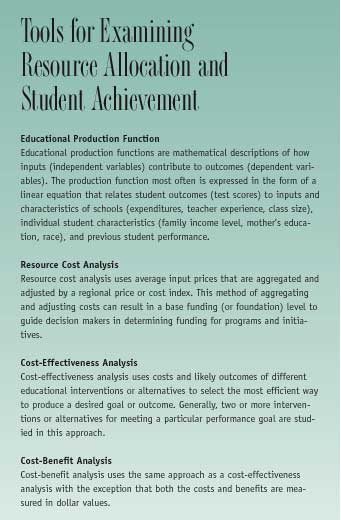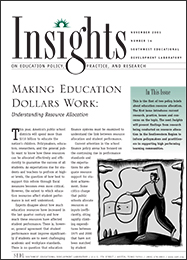Getting Results: Tools to Explore Resource Allocation
Conflicting or inconclusive research findings on the connection between resources and student performance should not lead educators and policymakers to conclude that little can be done to make resource allocation more effective. Experts who study school finance believe that resource allocation decisions can be improved when desired outcomes are articulated and  both the costs and benefits associated with reaching higher standards are understood and measured. For example, a new program to improve reading achievement may, when implemented, be dramatically successful. But if the program is 50 percent more successful and twice as expensive as a related program, policymakers will want to deliberate very carefully before they allocate resources to the more costly program. Economists have developed cost analysis tools for exploring ways to allocate resources efficiently, or to get the greatest results from given resource levels. These include resource cost analysis, cost-effectiveness analysis, and cost-benefit analysis.
both the costs and benefits associated with reaching higher standards are understood and measured. For example, a new program to improve reading achievement may, when implemented, be dramatically successful. But if the program is 50 percent more successful and twice as expensive as a related program, policymakers will want to deliberate very carefully before they allocate resources to the more costly program. Economists have developed cost analysis tools for exploring ways to allocate resources efficiently, or to get the greatest results from given resource levels. These include resource cost analysis, cost-effectiveness analysis, and cost-benefit analysis.
Resource cost analysis. Resource cost analysis is a systematic economic approach to identifying and pricing education inputs (Chambers, 1999). The general purpose of this approach is to identify all the costs associated with meeting a particular educational goal or requirement. When appropriate, the analyst adjusts the costs with a regional cost or price index. The advantage of resource cost analysis is that it identifies a complete set of elements to purchase, including those for special needs. The disadvantage for decision makers is that the total dollar cost of inputs alone has little connection to student performance. Some analysts, however, have used a variation of this approach to connect total dollars and student performance. The way they have done this is to study programs known or thought to be effective or programs that focus specifically on high-performing schools/districts and measure the costs they incur for their educational programs. In this way, analysts adjust for adequate or acceptable performance of students within a program or activity they are evaluating. The decision maker can then use the cost information generated from such a study  as a way to determine whether to fund certain activities or programs associated with high performance and as a standard for allocating resources to lower-performing entities.
as a way to determine whether to fund certain activities or programs associated with high performance and as a standard for allocating resources to lower-performing entities.
Education research expert Richard Rothstein used a variation on the resource cost approach to examine allocation among education program areas in a representative sample of school districts from several states from 1967 to 1996. He found that instructional spending increases over time were concentrated in special programs and not in general education programs. In fact, during the five years between 1991 and 1996, special education spending grew by 6.7 percent to account for 19 percent of all school spending in 1996. Bilingual education programs grew 30 percent during the same period. The importance of these results relates to the estimated efficiency of expenditure increases. If expenditure increases for instruction occur in programs that affect students who are less likely to be tested (e.g., those in special education or bilingual education), then comparing the combined expenditures for all programs to outcomes of only one (the general program) provides a misleading picture. The appropriate comparison would be to study resource costs and student outcomes within only the general education program.
Cost-effectiveness analysis. Studies that permit policymakers to understand both the costs and likely outcomes of different alternatives for student performance improvement are categorized as cost-effectiveness and cost-benefit analyses. To determine cost in a cost-effectiveness analysis, all needed program inputs, such as books, training for teachers, the cost of tutors or instructional aides, and needed space or facilities, are examined along with the estimated costs of contributed or volunteered resources. The effectiveness of alternative interventions can be determined by examining test score gains between the beginning and end of a school year. Score gains for students who participated in the alternative programs would be recorded along with the associated costs for each program. When all alternatives are evaluated according to how both their costs and their contributions meet the same outcome or goal, decision makers have the opportunity to select the alternatives that accomplish desired results using the fewest resources.
Cost-benefit analysis. Cost-benefit analysis employs an approach similar to that of cost-effectiveness analysis. The distinction is that cost-benefit analysis evaluates alternatives to meet a given goal by identifying both costs and benefits measured in monetary terms. The difficulty associated with placing a dollar value on outcomes from elementary and secondary education programs has discouraged the use of this technique, so analysts utilize  it less often. As with cost-effectiveness analysis, in selecting among several alternatives, the decision maker would choose the approach or program with the highest benefit-to-cost ratio (Levin & McEwan, 2001).
it less often. As with cost-effectiveness analysis, in selecting among several alternatives, the decision maker would choose the approach or program with the highest benefit-to-cost ratio (Levin & McEwan, 2001).
The cost analysis portion of both the cost-effectiveness and cost-benefit approaches requires researchers to identify all the costs of a program, including training, administrative costs, the contributions of volunteers, donations, and other program elements that are typically ignored when school districts decide to allocate resources to new programs. The benefits of going through this cost analysis process are valuable because they help education program managers and administrators understand the full cost of programs.
Next Page: Issues for State Policymakers

